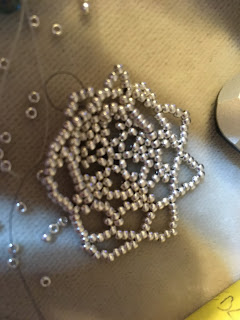Sorry for my delay in this post, I'd had a plan for it but then Life got in the way and I found myself distracted and a month has gone by.
So here it is. It's not so much as a "how to" but more my experience of trying to make creative designs on paper for my jewellery when I left Art as a subject behind when I completed my GSCE's and took a more science-based path (that's for another time though).
When I started bead weaving and bead embroidery, I used printed patterns by other people, and I still do, but there is nothing like making something from your own design.
But where to start...
For me, I usually look at what beads I have and simply make it up as I go along as inspiration takes me, but that can give varying results and not always good!
 |
| Beads!! Shapes, Sizes, Colour! |
 |
| A vague pattern in my head did not come out anything like how it should! |
I write poetry every now and then and I've got into the habit of keeping a notebook in almost every room of the house; now I scribble a half-thought-out design and then go back to it a few days later to add it to my more "permanent" sketchbook where I try to break it down into basic shapes - something I remember my art teacher always explaining this to me when I couldn't quite get a complex shape drawn accurately - faint pencil lines and then trace the outline with a darker pencil or a standard pencil simply pressed harder.
 |
| A pattern from criss-crossing elongated ovals... |
 |
| Trace the outline and a cute little butterfly is formed |
Not all my designs are like this (although I do like to do bead embroidery butterflies, dragonflies, leaves and such like), quite often I will have a bit of a "freestyle session" when I'm drawing, particularly when I'm thinking of doing a bead woven design and I will simply draw a sort of short-hand shapes that, to me, represent all the beads I am likely to use in a particular design.
Now, there are a number of software programmes that can do this for me, but to be honest, I've not really got the skills or knowledge to be able to use them effectively for what I want. I still prefer drawing and I take as much guidance as I can from online tutorials, books and magazines.
So my advice is do whatever you can to make the outline design for what you are after. Plus there is nothing as good as using a printer or tracing paper for a specific design if you are really stuck!
Until Next time...
Melanie, Bubbly Duck
Comments
Post a Comment